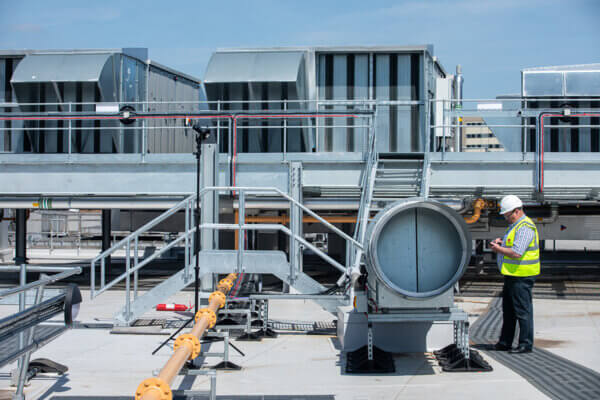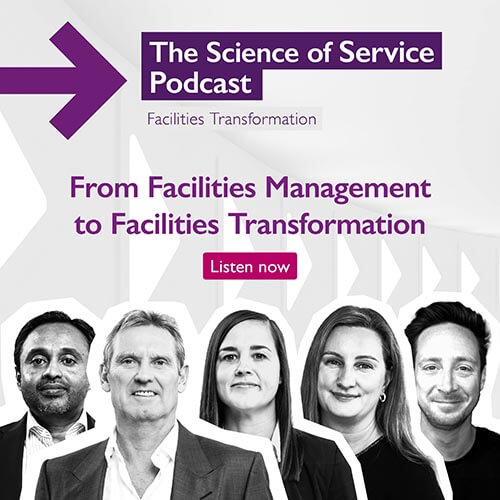Confronting the data centre controversy

What do online banking, film streaming and artificial intelligence (AI) have in common?
They each rely on data centres to function – along with much of the technology we depend upon to support our modern lifestyles.
In fact, these tech storage hubs are so fundamental to how we live, the UK Government is designating them part of the country’s critical national infrastructure.
This means it’s boom time for data centres – but not everyone is on board.
For this Perspectives article, Mitie expert, Elliott Bermudez Galton, refutes the most commonly-levelled criticism and reveals why data centres present an opportunity not to be missed.
I’m going to be honest. I love data centres. I’ve worked closely with multiple operators for the past decade and I have never tired of the futuristic environment. It looks like you’ve taken a wrong turn on the Death Star space station and stumbled into the server room.
A data centre typically has massive amounts of floor space and lots of little boxes on rows and rows of racks. What’s inside those boxes? Well, they contain the lives of much of the world’s population, who rely on data centres for photo storage, gaming, global travel and a lot more. As I see it, they’re essential to how we live today. But not everyone feels the same way.
No time for nimbyism
Data centres are large and, because they use so much electricity, they need to be in locations that are well-connected to the Grid. The acronym NIMBY for ‘Not In My Back Yard’ is common in the UK – and unfortunately it’s particularly apt for the nimbies’ prevailing attitude to data centres.

I would ask anyone who opposes the growth of the data centre industry to consider how they live. Do they want to be able to use social media? To work flexibly? To make video calls to friends and family? We can only continue using modern technology if there are enough data centres to back it up.
Keep the UK running
The main data centre sites across Europe are referred to as FLAP-D – Frankfurt, London, Amsterdam, Paris and Dublin. But as they are all nearing capacity, there’s an explosion in secondary locations. Here in the UK, that means places like Newcastle and Manchester stand to benefit. Gaining support from the local community is important. It’s about highlighting jobs creation, promoting the chance to upskill, work in a thriving sector and do your bit to keep the UK running.
Data centre servers generate a lot of heat, so there is the potential for organisations to divert that elsewhere. For example, it’s possible to power a district heat network, or warm up the local swimming pool. There are lots of ways to boost the area beyond employment opportunities, giving back to the community.
An AI essential
The appetite for AI in both private and professional quarters is staggering. This is demonstrated by the enthusiasm for OpenAI’s ChatGPT. Within six months of launching, it saw 100m monthly users. We all want a piece of the action.
AI continues to emerge at a pace that’s hard to fathom. We’re experiencing the AI revolution, but if we want it to continue, data centres must be part of our future landscape. They are essential AI infrastructure, facilitating the acceleration in computations from less complex cloud computing. So, there’s no AI without data centres.
Powering sustainability
Data centres consume an incredible amount of energy. Many of their greatest critics claim this makes them unsustainable and a major block on the journey to decarbonisation. This doesn’t have to be the case.
The Climate Neutral Data Centre Pact is a commitment from data centre operators to reach net zero by 2030. Clearly they are serious about their sustainability obligations. Delivering on their promise may be challenging, but it’s very much within reach.

From Mitie’s perspective, we’re here to plan and build sustainable data centres that power the AI revolution. As a strategic partner, we can implement power solutions, such as on-site generation, that get around any green power capacity issues. We’ll manage energy to make sure customers are protected from fluctuating costs. It’s much cheaper and more efficient to embed sustainability along the way than to bolt it on at the end. With a bit of forward planning and blue sky thinking, sustainable data centres are absolutely possible. Embed sustainability from day one, and it’s never been a better time to run one efficiently.
Golden opportunity
The UK is now at the centre of a data centre ‘gold rush’. We’ve built more than most countries in the EU because we needed our own data storage, post-Brexit. That has helped grow the industry and now we’re seeing some of the world’s leading data centre players, such as the USA and Singapore, investing in the UK. To really seize the opportunity, we need joined-up thinking and a long-term plan. This should be backed by Government and address all the contentious elements I’ve touch upon, from local opposition to energy capacity and sustainability. Without doubt the UK is marching towards being the world leader in data centres – but we need to keep up the pace.

Do you agree with Elliott? Share your thoughts by emailing [email protected].
Read next

Critical infrastructure, complacency creep and how to avoid it
There have been a few ‘pinch yourself’ moments in my career. One of them came when I descended into an empty water reservoir beneath one of the UK’s busiest transport hubs. It was a…

The Science of Service Podcast: The golden opportunity of ‘black box’ tech
As we approach the end of the podcast series, Chris and I are in a reflective mood. If The Science of Service is the banner to showcase Mitie’s drive towards facilities transformation, what have…
 Skip to content
Skip to content